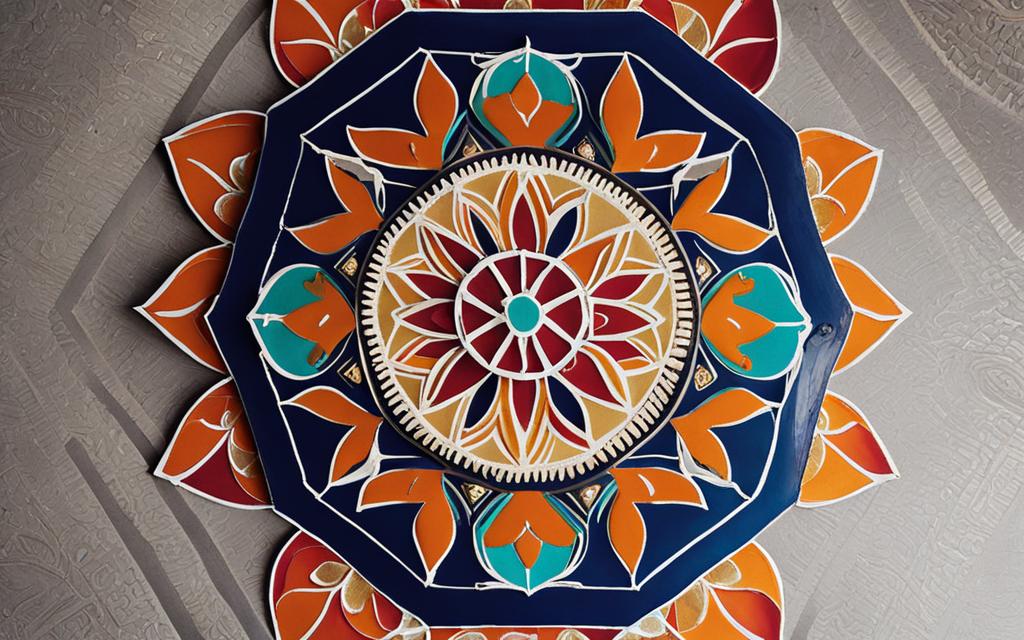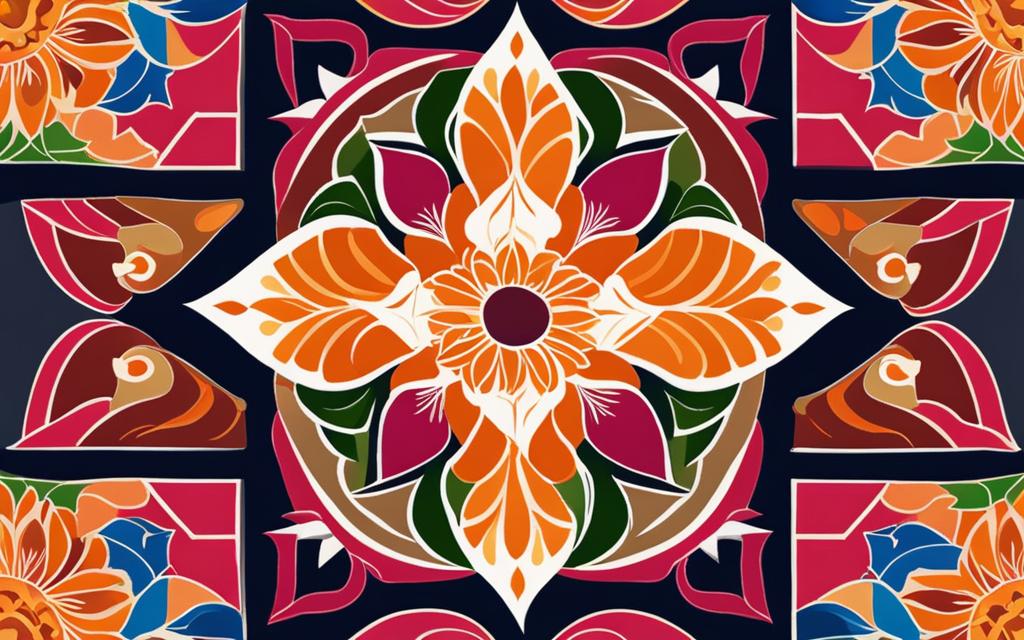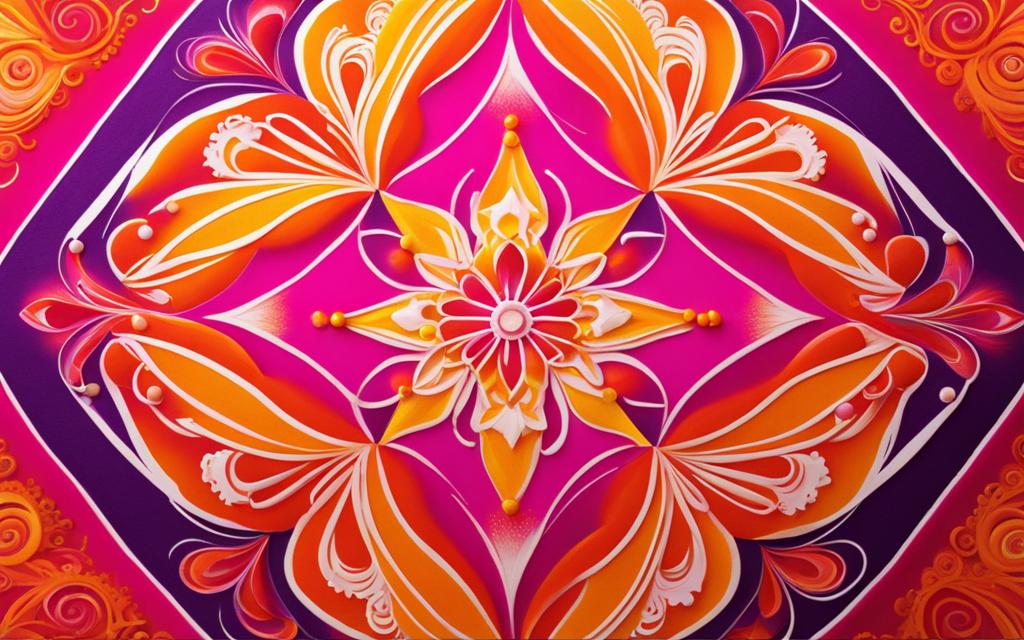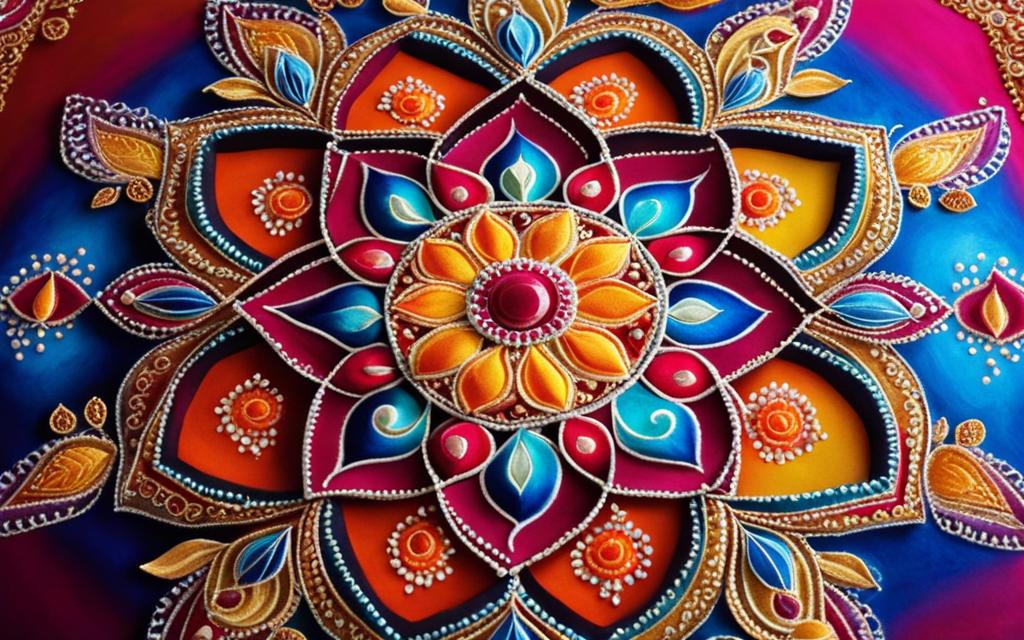Greetings, my dear readers. Today, I am thrilled to delve into the enchanting world of rangoli designs, specifically the modern unique rangoli designs that have been capturing hearts and minds.
Rangoli, as you may know, is an ancient Indian art form that holds deep cultural and religious significance across the country. It is a vibrant decorative pattern made with coloured powders, rice, flowers, or other materials, believed to bring good luck, prosperity, and positive energy to the household.

These mesmerizing designs have a rich historical background and can be created using a variety of materials and techniques. They are an integral part of various Indian festivals and celebrations, reflecting the cultural diversity of our beloved nation.
Throughout this article, I will guide you on a journey through the significance, historical background, materials, techniques, and the beauty of both traditional and contemporary rangoli designs.
You will discover how this ancient art form has evolved, embracing modern styles and techniques while maintaining its deep-rooted essence and charm.
So let’s embark on this colourful adventure together and unravel the contemporary elegance of modern unique rangoli designs, celebrating tradition and creativity in perfect harmony.
Table of Contents
- 1 The Significance of Rangoli Designs
- 2 Historical Background of Rangoli Designs
- 3 Materials and Techniques of Rangoli Designs
- 4 Festivals and Occasions for Modern Unique Rangoli Designs
- 5 Contemporary Rangoli Designs
- 6 Conclusion – Modern Unique Rangoli Designs
- 7 FAQ – Modern Unique Rangoli Designs
- 7.1 What is the significance of rangoli designs?
- 7.2 How are rangoli designs created?
- 7.3 What materials are used in traditional rangoli designs?
- 7.4 Are there different styles of rangoli designs?
- 7.5 When are rangoli designs typically created?
- 7.6 How have contemporary artists contributed to rangoli designs?
- 7.7 What is the cultural heritage associated with rangoli designs?
- 8 Source Links
The Significance of Rangoli Designs
Rangoli designs, with their vibrant colours and intricate patterns, hold significant cultural and religious importance in India.
These beautiful decorative patterns, created using coloured powders, rice, flowers, or other materials, are believed to bring good luck, prosperity, and positive energy to the household. Rangoli designs are not just mere decorations; they are symbols of auspiciousness and well-being.
Creating rangoli designs is a cherished tradition during festive occasions and special celebrations. These designs act as a warm welcome for deities and serve as a way to honor auspicious moments.
They adorn the entrances of homes and public spaces, spreading joy and positivity. The act of creating rangoli designs is considered an art form, a means of self-expression, and a way to celebrate cultural diversity.
The cultural significance of rangoli designs goes beyond just their aesthetic appeal. It represents the harmonious coexistence of nature and humanity. The use of natural materials, such as rice flour and flower petals, reflects our connection with the environment.
By creating rangoli designs, we pay homage to the traditions of our ancestors and preserve our rich heritage for future generations.
The Symbolism Behind Rangoli Designs
Each element of a rangoli design holds symbolic meaning. The use of vibrant colours represents joy, prosperity, and celebration.
Circular patterns symbolize unity, wholeness, and eternity. Geometric shapes, such as squares, triangles, and circles, convey balance and harmony. The inclusion of religious symbols and motifs reflects devotion and reverence towards deities.
- Rangoli designs help set a positive and auspicious atmosphere during festivals and special occasions.
- They are believed to ward off evil spirits and bring good luck and prosperity to the household.
- Rangoli designs act as a form of meditation and mindfulness, allowing individuals to focus their thoughts and channel positive energy.
- They serve as a way to showcase creativity, express cultural identity, and uphold traditions.
- By creating rangoli designs, we preserve and pass on our cultural heritage to future generations.
Rangoli designs are not just patterns on the ground; they are a reflection of our values, beliefs, and aspirations.
They bring communities together, create a sense of unity and belonging, and remind us of the beauty and richness of our cultural heritage.
Historical Background of Rangoli Designs
The Evolution of Rangoli
The art of rangoli has a fascinating historical background that dates back several centuries. It originated as a humble practice of creating simple designs using rice flour, serving as a way to feed ants and birds, exemplifying the harmony between humans and nature.
As time went on, rangoli evolved into a form of artistic expression and a medium for storytelling, captivating audiences with its intricate patterns and vibrant colours.
Regional Variations and Cultural Heritage
India’s cultural diversity shines through the myriad of regional variations in rangoli designs. Each state has its own distinct style, such as the Alpana in West Bengal, the Kolam in Tamil Nadu, and the Madana in Rajasthan.
These regional variations showcase the rich heritage associated with rangoli, reflecting the unique traditions, customs, and aesthetics of each region.
A Visual Narrative
Rangoli designs go beyond being mere decorative patterns; they are visual narratives that tell stories, depict myths and legends, and celebrate life’s auspicious moments.
Through these intricate designs, artists convey their emotions, beliefs, and cultural values, inviting viewers into a world of symbolism and deep spiritual significance.

Materials and Techniques of Rangoli Designs
Creating beautiful rangoli designs is a delightful and creative process that requires minimal materials. Traditionally, vibrant coloured powders like rice flour, turmeric, vermillion, and natural dyes were used to bring life to the designs.
However, modern variations have embraced the use of diverse materials such as flower petals, coloured sand, chalk, and even acrylic paints. This allows artists to experiment with different textures, colours, and effects, giving their rangoli designs a unique touch.
When it comes to techniques, the possibilities are endless. The process begins with drawing an outline using chalk or a pencil, providing a framework for the design.
Then, the artist carefully fills the outline with the chosen materials, whether it be powders, petals, or other creative elements.
The intricate patterns, geometric shapes, and religious symbols are common motifs found in rangoli designs, adding depth and meaning to the artwork.
The Materials used in Rangoli Designs:
- Vibrant coloured powders
- Rice flour
- Turmeric
- Vermillion
- Natural dyes
- Flower petals
- coloured sand
- Chalk
- Acrylic paints
The Techniques used in Creating Modern Unique Rangoli Designs:
- Drawing an outline using chalk or a pencil
- Selecting and arranging the materials
- Carefully filling the design with colours or materials
- Adding intricate patterns, geometric shapes, and religious symbols
With these versatile materials and techniques, artists can explore their creativity, blending tradition and innovation to create unique and mesmerizing rangoli designs that captivate the eye and celebrate the beauty of Indian culture.

Festivals and Occasions for Modern Unique Rangoli Designs
Rangoli designs hold a special place in Indian festivals and celebrations, adding a vibrant touch to the festivities.
Let’s explore some of the prominent Indian festivals where rangoli designs take center stage:
1. Diwali
Diwali, also known as the Festival of Lights, is one of the most significant festivals celebrated in India. Rangoli designs play a crucial role in Diwali celebrations, with intricate patterns adorning the entrance of homes and temples.
These rangoli designs are created to welcome Goddess Lakshmi, the deity of wealth and prosperity. The combination of vibrant colours and artistic patterns adds to the festive ambiance and reflects the joyous spirit of Diwali.
2. Pongal
Pongal is a harvest festival celebrated in Tamil Nadu, dedicated to the Sun God. As a way of expressing gratitude for a bountiful harvest, people create rangoli designs, known as Kolam, using rice flour.
These beautiful patterns are created outside homes and signify prosperity and good fortune. The Kolam rangoli designs are often adorned with vibrant colours, flowers, and geometric patterns, showcasing the rich cultural heritage of Tamil Nadu.
Navratri is a vibrant and colourful festival celebrated across India, dedicated to the worship of Goddess Durga. Rangoli designs are an integral part of Navratri decorations, symbolizing the triumph of good over evil.
During the nine nights of Navratri, different themes and motifs are depicted through rangoli designs, ranging from traditional symbols to modern artistic interpretations.
The use of vibrant colours and intricate patterns adds to the festive fervor and enhances the spiritual atmosphere.
4. Onam
Onam is a harvest festival celebrated in the southern state of Kerala, marking the homecoming of the mythical King Mahabali. Rangoli designs, known as Pookalam, are an essential part of Onam celebrations.
These intricate designs are created using flower petals, forming beautiful patterns and motifs. Pookalam rangoli designs are a visual treat, reflecting the natural beauty of Kerala and the cultural significance of the festival.

Rangoli designs add a touch of elegance, beauty, and cultural significance to Indian festivals. Whether it’s Diwali, Pongal, Navratri, or Onam, these vibrant patterns bring joy, positivity, and a sense of community.
Through their intricate patterns and vibrant colours, rangoli designs capture the essence of Indian culture and highlight the artistic skills of the people.
Embrace the festive spirit and create your own rangoli designs to celebrate these joyous occasions.
Contemporary Rangoli Designs
Contemporary artists have breathed new life into the traditional art form of rangoli, infusing it with innovative styles and techniques.
With their creativity and imagination, these artists have taken rangoli to new heights, creating modern designs that captivate the eyes and spark the imagination.
One of the ways contemporary artists have pushed the boundaries of rangoli is through the use of stencil work.
By using stencils, artists can achieve intricate and precise patterns, adding a level of intricacy to their designs. Stencil work allows for the creation of complex designs that would be difficult to achieve by freehand drawing alone.
Another technique that contemporary artists have embraced is mixed media. By incorporating various materials such as beads, mirrors, and even tiny LED lights into their rangoli designs, these artists have added a touch of whimsy and modernity to the traditional art form.
Mixed media rangoli designs are visually stunning and create an interactive experience for viewers, as they change and evolve with different lighting conditions.
Contemporary Rangoli Designs: A Fusion of Tradition and Creativity
Contemporary rangoli designs offer a fusion of tradition and creativity, allowing artists to explore their individual styles and showcase their artistic vision.
These designs not only pay homage to the rich cultural heritage of India but also serve as a testament to the evolving nature of art.
From intricate patterns inspired by nature to abstract designs that reflect contemporary aesthetics, contemporary rangoli designs are a celebration of the ever-changing art form.
As we celebrate the beauty and vibrancy of rangoli designs, let us appreciate the talent and ingenuity of the contemporary artists who are keeping this ancient art form alive and relevant.
Their innovative styles, stencil work, and use of mixed media have breathed new life into rangoli, ensuring its enduring place in the artistic landscape of India.
- Contemporary artists have introduced innovative styles and techniques to rangoli designs.
- Stencil work allows for the creation of intricate and precise patterns.
- Mixed media rangoli designs incorporate various materials, adding a touch of whimsy and modernity.
- Contemporary rangoli designs offer a fusion of tradition and creativity, showcasing the ever-changing nature of art.
Conclusion – Modern Unique Rangoli Designs
Rangoli designs are a true reflection of the cultural heritage and artistic creativity of India. These captivating patterns, filled with vibrant colours and intricate details, hold a special place in our hearts and homes.
Whether it’s the auspicious occasion of Diwali or any other festive celebration, rangoli designs bring joy, positivity, and a sense of beauty to our lives.
The aesthetic value of rangoli designs cannot be understated. They not only enhance the visual appeal of our surroundings but also serve as a means of self-expression and celebration.
From traditional motifs that have been passed down through generations to modern variations that showcase innovative styles, rangoli designs continue to mesmerize us with their timeless charm.
As we celebrate Diwali and other festivities, let us embrace the rich cultural heritage of our country and the boundless creativity that rangoli designs offer.
They are a testament to the artistic prowess of our ancestors and a reflection of our vibrant traditions.
So, let your imagination soar, and create your own unique rangoli designs, adding a touch of elegance and colour to your celebrations.
>> Please read my other interesting posts here:
FAQ – Modern Unique Rangoli Designs
What is the significance of rangoli designs?
Rangoli designs are believed to bring good luck, prosperity, and positive energy to the household. They hold deep cultural and religious importance in India.
How are rangoli designs created?
Rangoli designs can be created using coloured powders, rice, flowers, or other materials. The process includes drawing an outline and filling the design with colours or materials of choice.
What materials are used in traditional rangoli designs?
Traditional rangoli designs are made using vibrant coloured powders, rice flour, turmeric, vermillion, and natural dyes.
Are there different styles of rangoli designs?
Yes, various regions in India have their distinct styles of rangoli, such as Alpana in West Bengal, Kolam in Tamil Nadu, and Madana in Rajasthan.
When are rangoli designs typically created?
Rangoli designs are an integral part of various Indian festivals and celebrations. They are often created during Diwali, Pongal, Navratri, Onam, and other festive occasions.
How have contemporary artists contributed to rangoli designs?
Contemporary artists have introduced innovative styles and techniques to rangoli designs, incorporating new themes, techniques like stencil work and mixed media, and pushing the boundaries of traditional rangoli.
What is the cultural heritage associated with rangoli designs?
Rangoli designs exemplify the beauty, creativity, and cultural heritage of India. They not only add aesthetic value to homes and public spaces but also serve as a means of self-expression and celebration.
